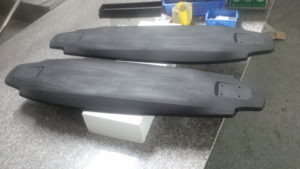Surface finishing in rapid prototyping refers to the different processes that are used to alter the feel and look of the products so they achieve the desired look or to be as distinct as possible. Different techniques are used by rapid prototype manufacturers to meet the need in terms of improving adherence, conductivity, appearance and resistance to things like corrosion and many other aspects. Using the different surface finish services can finally have a prototype that is exactly as you wish for it to be even in performance, aesthetics and durability. Below are some of the commonly used methods to achieve the different surface finishes in rapid prototypes.

Blasting – The method involves controlled spraying of abrasive media against the prototype surface. Media like garnet, sand, metal beads and walnut shells can be used for this purpose to clean the parts and getting them chemically and mechanically ready for other finishes. The process also improves the mechanical properties of metallic parts by improving resistance to corrosion and increasing fatigue strength. It in the end imparts unique pebbling, frosting and textures.
Painting – It is one of the best surface finish processes for those wishing to have their products standing out from the rest. You can have the professionals replicate any color, hue or tint you wish for your parts in glossy, semi-gloss, flat or even matte finishes. Custom painted textures are also possible to achieve as long as you choose an experienced prototype company with excellent services.
Anodizing – It is usually done on titanium, magnesium and aluminum and helps in adding corrosion resistance, and improving resistance to dissipate heat and wear. This process also increases the hardness of the surface at the same time giving it a great look. Tints and dyes can be added to the parts to achieve desired visual effects.
Sanding – Sanding is not only applicable in preparing for painting but also in achieving a final surface finish for your prototypes. Abrasive particles are rubbed against the part surface for non-linear random surface texture. The cutting grains are in different sizes referred to as grit; the higher the grit the finer and smaller the particles are resulting into fine surface finish in the end. Coarse grits in the other hand can remove lots of material fast. If your parts are curved or contoured, this is a very good method to achieve the desired texture.
Vapor polishing – It is a method used to achieve clear surfaces especially around hard to reach areas and complex geometrics. If your parts are polycarbonate plastic made then you can easily achieve optical clarity using vapor polishing.
Lapping – It is used on metal prototypes to achieve high degrees of refinement and flatness on the surface. Soft iron tools are used together with mild abrasive slurries to work the surface with light, random and non-linear motions. The hand motions flatten high spots and fills microscopic surface voids for a refined part in the end. Machines can also be used but in slow motions so the piece being worked on does not heat up.
An experienced and qualified rapid prototyping Factory in China can help you achieve any surface finish you want for your custom-made fast prototypes. There are so many finishing methods that the Chinese prototype manufacturers use to achieve the different textures making everything possible for your parts.
For more information, please refer to www.rapidprototypechina.com.